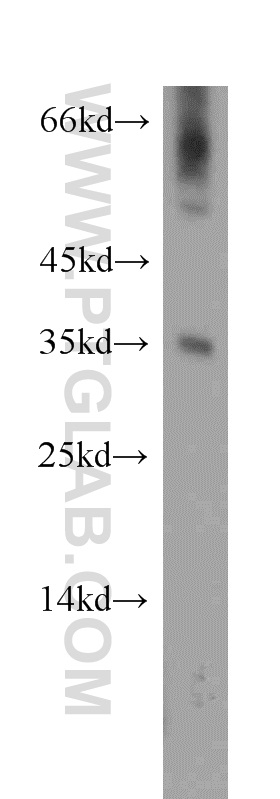验证数据展示
经过测试的应用
| Positive WB detected in | mouse liver tissue |
推荐稀释比
| 应用 | 推荐稀释比 |
|---|---|
| Western Blot (WB) | WB : 1:500-1:2000 |
| It is recommended that this reagent should be titrated in each testing system to obtain optimal results. | |
| Sample-dependent, Check data in validation data gallery. | |
产品信息
11948-1-AP targets DOK5 in WB, ELISA applications and shows reactivity with human, mouse, rat samples.
| 经测试应用 | WB, ELISA Application Description |
| 经测试反应性 | human, mouse, rat |
| 免疫原 |
CatNo: Ag2615 Product name: Recombinant human DOK5 protein Source: e coli.-derived, PGEX-4T Tag: GST Domain: 1-198 aa of BC008992 Sequence: MECVGTRINDISLGEPDLLATGVEREQSERFNVYLMPSPNLDVHGECALQITYEYICLWDVQNPRVKLISWPLSALRRYGRDTTWFTFEAGRMCETGEGLFIFQTRDGEAIYQKVHSAALAIAEQHERLLQSVKNSMLQMKMSERAASLSTMVPLPRSAYWQHITRQHSTGQLYRLQDVSSPLKLHRTETFPAYRSEH 种属同源性预测 |
| 宿主/亚型 | Rabbit / IgG |
| 抗体类别 | Polyclonal |
| 产品类型 | Antibody |
| 全称 | docking protein 5 |
| 别名 | C20orf180, docking protein 5, DOK5, IRS 6, IRS6 |
| 计算分子量 | 306 aa, 35 kDa |
| 观测分子量 | 35 kDa |
| GenBank蛋白编号 | BC008992 |
| 基因名称 | DOK5 |
| Gene ID (NCBI) | 55816 |
| RRID | AB_10665550 |
| 偶联类型 | Unconjugated |
| 形式 | Liquid |
| 纯化方式 | Antigen affinity purification |
| UNIPROT ID | Q9P104 |
| 储存缓冲液 | PBS with 0.02% sodium azide and 50% glycerol, pH 7.3. |
| 储存条件 | Store at -20°C. Stable for one year after shipment. Aliquoting is unnecessary for -20oC storage. |
背景介绍
DOK5 belongs to the docking family of proteins that contain tandem pleckstrin homology-phosphotyrosine binding (PH-PTB) domains at their amino termini (PMID: 19909370). DOK proteins are also known as INS receptor substrates (IRS) and serve as substrates for INS and INS-like growth factor (PMID: 12730241 ) as well as various protein tyrosine kinases (PMID: 16647839). DOK5 functions as a specific signal transduction molecule and plays an important role in cellular differentiation. DOK5 is upregulated in systemic Sclerosis and Associated with IGFBP-5-Induced fibrosis (PMID: 24551065).
实验方案
| Product Specific Protocols | |
|---|---|
| WB protocol for DOK5 antibody 11948-1-AP | Download protocol |
| Standard Protocols | |
|---|---|
| Click here to view our Standard Protocols |


